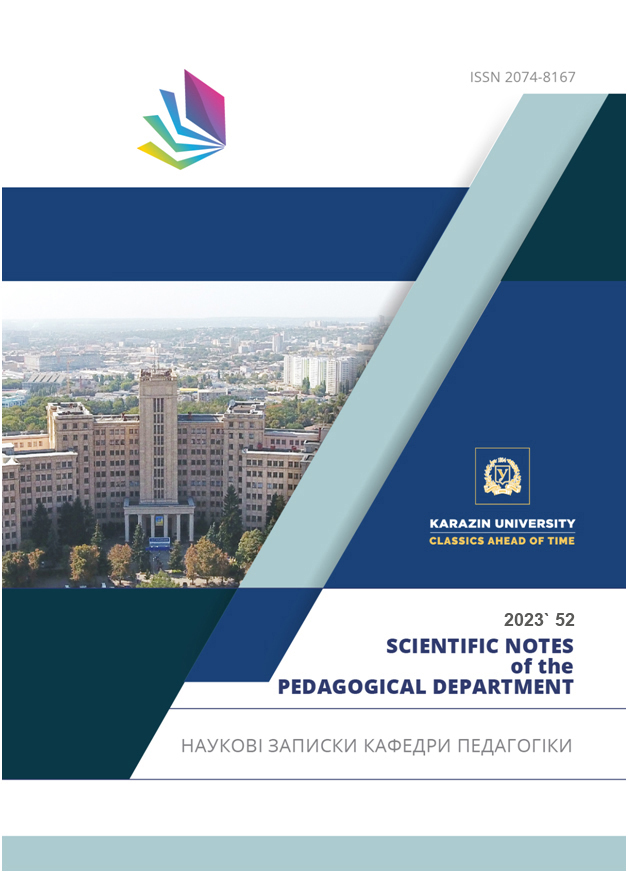Informal structures as a factor of youth socialization: social and pedagogical aspect
Abstract
Informal youth structures are a diverse and non-transferable phenomenon in our modernity.
A person joins an informal group to be satisfied, ask for respect, mutual assistance, mutual protection
and close communication.
The empirical base of the study is made up of data, subtracting the hour of the experiment, as it was
carried out with the help of Google Form (141 persons, most of the interviews were conducted in 18 to 22
years). The main century group, as it took part in the internship, were young people from 13 to 23 years
old, so that schoolchildren and students, could take a part in different subcultures of fandoms.
As a reminder of the research carried out, the result of the interaction of young people with
informal structures / subcultures is both positively and negatively signified on the socialization of young
people. In order to help the socialization of their developments, teachers can work indirectly through
informal structures and secretly “control” those who are involved, promote the singing of values and
reconciliation, and at the same time instill in and swing participants in these structures. Similar to the
mutual understanding, search for sleepy floods, the exchange of knowledge can become a point in the
interests and purposes of teachers and pupil, which promotes mutual understanding between them, as a
result, accepting the effectiveness of pedagogical practices.
Downloads
References
Abercromby, N., Hill, S., Turner, B. (2004). Sociological dictionary.
Karpova, A. V. (2018). Socialization of teenagers in the environment of youth subcultures. Collection of scientific works of RDSU. Issue 11, Access mode: https://prap.rv.ua/index.php/prap_rv/article/view/11/11 [in Ukrainian].
Pavelkiv, V. R. (2015). Youth subculture and its influence on the process of personality identification. Psychology: reality and prospects. Vol. 5. P. 117-123. Access mode: http://nbuv.gov.ua/UJRN/prp_2015_5_23г [in Ukrainian].
Subculture. Literary encyclopedia: in 2 volumes / author-compiler. Yu. I. Kovaliv. (2007). Kyiv: “Academy” Center, T. 2. P. 442. [in Ukrainian].
Subculture. Encyclopedia of Education / Academy of Ped. Sciences of Ukraine; Editor in Chief. V. G. Kremin. (2008). K.: Yurinkom Inter. P. 884. [in Ukrainian].
Brosnan, M.J. (1998). Technophobia: the psychological impact of Information Technology. pg 155. London: Routledge.
Clute, John (1997). Encyclopedia of Fantasy (1997) Society for Creative Anachronism». sf-encyclopedia.uk. Retrieved 2019-11-10.
Cromdal, Jakob (2006). Socialization. In K. Brown (ed.). Encyclopedia of language and linguistics. North-Holland: Elsevier. pp. 462–66. doi:10.1016/B0-08-044854-2/00353-9. ISBN 978-0080448541.
«Fandom - Definition of fandom by Merriam-Webster». merriam-webster.com.
Hurrelmann, Klaus and Quenzel, Gudrun (2019) Developmental Tasks in Adolescence. London/New York: Routledge.
Jones, Steve E. (2006). Against technology: from the Luddites to neo-Luddism. CRC Press. с. 20. ISBN 978-0-415- 97868-2.
Maccoby, E.E. & Martin, J.A. (1983). Socialization in the context of the family: Parent-child interaction. In P. H. Mussen (Series Ed.) & E.M. Hetherington (Vol. Ed.), Handbook of Child Psychology: Vol. 4. Socialization, personality, and social development (4th ed., pp. 1–101). New York: Wiley.
Macionis, Gerber, John, Linda (2010). Sociology 7th Canadian Ed. Toronto, Ontario: Pearson Canada Inc. p. 111.
Moreland, Richard L.; Levine, John M. (1982). Socialization in Small Groups: Temporal Changes in Individual- Group Relations. Advances in Experimental Social Psychology. Vol. 15. pp. 137–92. doi:10.1016/S0065- 2601(08)60297-X. ISBN 978-0120152155.
Plomin, R. (1990). Nature and nurture: An introduction to human behavioral genetics. Paciꢁic Grove, CA: Brooks/Col.
Stanfill, Mel; Condis, Megan (2014-03-15). «Fandom and/as labor». Transformative Works and Cultures. 15. doi:10.3983/twc.2014.0593. ISSN 1941-2258. S2CID 142712852.
Youth Cultures: Scenes, Subcultures and Tribes. CRC Press.

